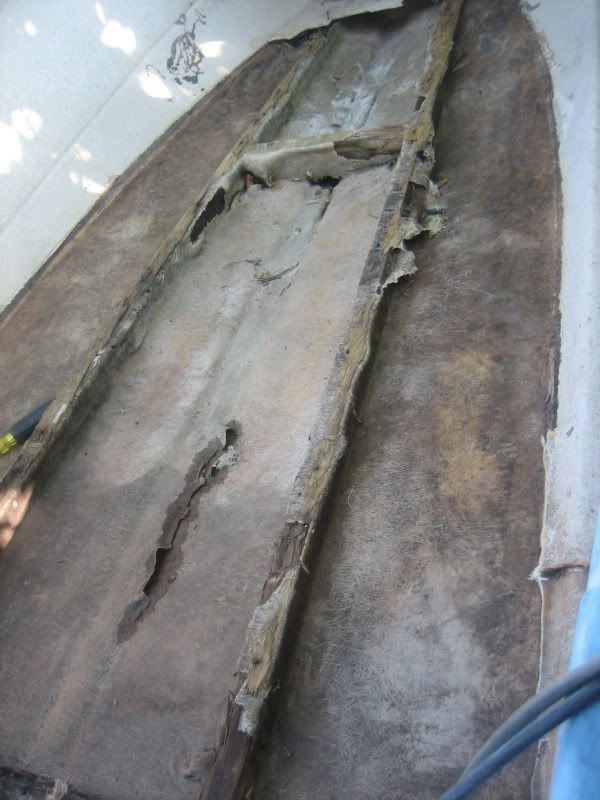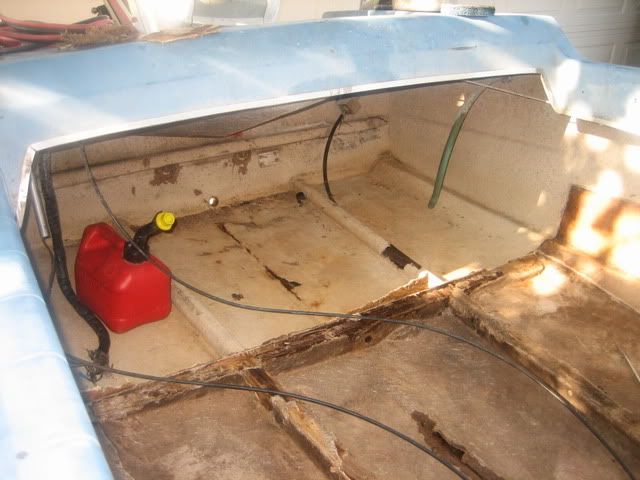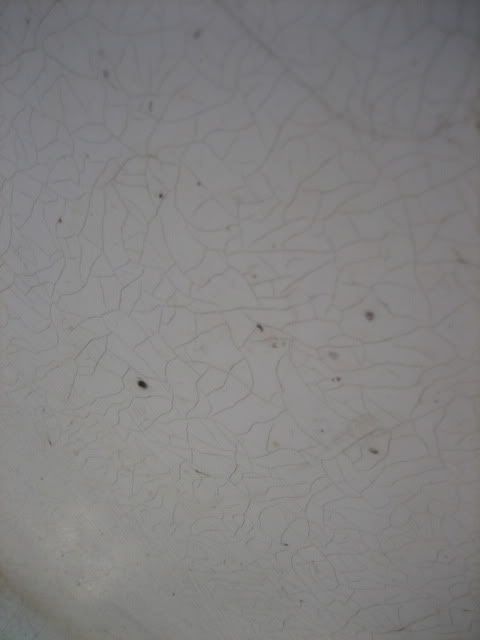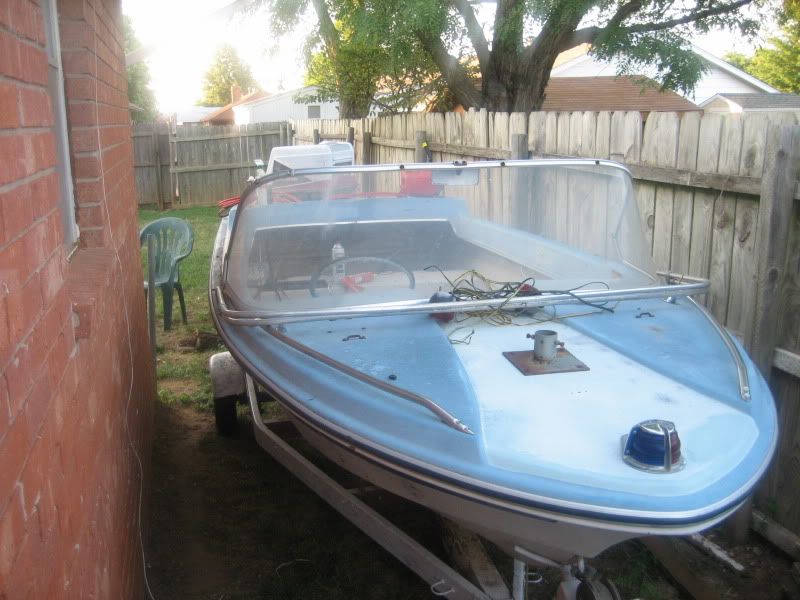Hello, I am new here and to the world of boat repair. I have been been reading about a lot of other people's projects like the oops hull extension and am getting very excited about working on my own. Recently i bought a 15ft elgin runabout that had a 'running' 75hp 'rude and the trailer all for only 100 bucks! All it needed was a floor and so it sounded like to good a deal to pass up since all you have to do is slap some plywood down, right?  Well as i spent time getting the engine to actually run i learned there was a lot more to it than that.
Well as i spent time getting the engine to actually run i learned there was a lot more to it than that.
I was able to rip most of the rest of the deck out with my hands the wood under it was very rotten and there was no glass to help seal it. For the most part the stringers are in good shape considering when i got the boat the middle of the deck had been ripped out and it sat fairly flat in the middle of a field. The wood feels a little soft but stands up to being stabbed by my screwdriver pretty well. But it would seem to me that they had used only one layer of CSM around them.
l

Here you can see that a lot of the glass is missing and like on the right side it has curled away from the stringers. The dark spot in the middle is where a layer of glass has come apart from the keel allowing water to flow into the huge gap between layers all the way along keel.
After getting the rest of the deck out, I started cutting out the bench seat. I then had access to the wood where water pooled up in the field and it is definitely rotten. I only hope to be able to get in out in a good enough piece to have a template.

Here you see the bilge (i believe thats what you would call this). The dark spot on the port stringer is the only place i could peel glass off of either of them and the wood there while dark is very hard. There is more glass peeling off of the keel here, it would seem worthwhile to fill it PB before glassing over it again. It would seem that this part of the boat has stayed relatively dry judging from the condition of the stringers and that gives me hope for the transom. I have yet to drill in it and dont know if i need to. It feels very solid when moving the engine around.
So now to the part where i need some help. As i was ripping out the deck and walking on the hull i would occasional hear a cracking sound and thought it was that hull. I tried bouncing lightly on it to see if i would fall though (sorta my test to see if i should throw it all away). As i walk around i can see the fiberglass flexing. Later i noticed on the bottom of the hull everywhere i had stepped a massive amount of crazing had appeared.


In this picture you can sorta see cracks that have formed on the inside of the hull, you can't feel any of the cracks on the inside. The ones on the outside you can fell but they arent big enough to catch your fingernail on. The crazing is also not nearly so defined if you wipe it with a cloth. The cloth becomes very white as it removes a layer of something
My question is. Is this a normal (or at least safe) condition for a boat this old? And, can it be fixed?
My thought is to remove one stringer at a time, and after doing a lot of ruff and scuff on that side i would lay 1.5oz CSM from bow to stern and from 6" away from the other stringer to 38" up the wall. Then add a layer of 18oz woven roving. That would essentially cover the entire bottom and all but the top of the side. I would then replace the stinger and repeat the process on the other side. That would give me about 6" overlap on top of the keel. doing all of this with polyester resin.
Would doing that sufficiently reinforce the hull? or is it even necessary?
Should i use a different type of cloth than the roving? From what i have read the CSM seems necessary to form a bond between the old and the new fiberglass.
Thank you for taking the time to read about my boat. I greatly appreciate any help you guys offer to this boating newbie.
-Stuart
P.S. Here is a pic of her hiding behind my house. Soon to move into the garage for some work.

I was able to rip most of the rest of the deck out with my hands the wood under it was very rotten and there was no glass to help seal it. For the most part the stringers are in good shape considering when i got the boat the middle of the deck had been ripped out and it sat fairly flat in the middle of a field. The wood feels a little soft but stands up to being stabbed by my screwdriver pretty well. But it would seem to me that they had used only one layer of CSM around them.
l

Here you can see that a lot of the glass is missing and like on the right side it has curled away from the stringers. The dark spot in the middle is where a layer of glass has come apart from the keel allowing water to flow into the huge gap between layers all the way along keel.
After getting the rest of the deck out, I started cutting out the bench seat. I then had access to the wood where water pooled up in the field and it is definitely rotten. I only hope to be able to get in out in a good enough piece to have a template.

Here you see the bilge (i believe thats what you would call this). The dark spot on the port stringer is the only place i could peel glass off of either of them and the wood there while dark is very hard. There is more glass peeling off of the keel here, it would seem worthwhile to fill it PB before glassing over it again. It would seem that this part of the boat has stayed relatively dry judging from the condition of the stringers and that gives me hope for the transom. I have yet to drill in it and dont know if i need to. It feels very solid when moving the engine around.
So now to the part where i need some help. As i was ripping out the deck and walking on the hull i would occasional hear a cracking sound and thought it was that hull. I tried bouncing lightly on it to see if i would fall though (sorta my test to see if i should throw it all away). As i walk around i can see the fiberglass flexing. Later i noticed on the bottom of the hull everywhere i had stepped a massive amount of crazing had appeared.


In this picture you can sorta see cracks that have formed on the inside of the hull, you can't feel any of the cracks on the inside. The ones on the outside you can fell but they arent big enough to catch your fingernail on. The crazing is also not nearly so defined if you wipe it with a cloth. The cloth becomes very white as it removes a layer of something
My question is. Is this a normal (or at least safe) condition for a boat this old? And, can it be fixed?
My thought is to remove one stringer at a time, and after doing a lot of ruff and scuff on that side i would lay 1.5oz CSM from bow to stern and from 6" away from the other stringer to 38" up the wall. Then add a layer of 18oz woven roving. That would essentially cover the entire bottom and all but the top of the side. I would then replace the stinger and repeat the process on the other side. That would give me about 6" overlap on top of the keel. doing all of this with polyester resin.
Would doing that sufficiently reinforce the hull? or is it even necessary?
Should i use a different type of cloth than the roving? From what i have read the CSM seems necessary to form a bond between the old and the new fiberglass.
Thank you for taking the time to read about my boat. I greatly appreciate any help you guys offer to this boating newbie.
-Stuart
P.S. Here is a pic of her hiding behind my house. Soon to move into the garage for some work.




















